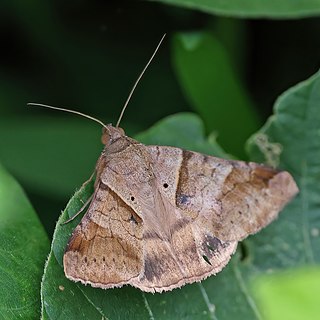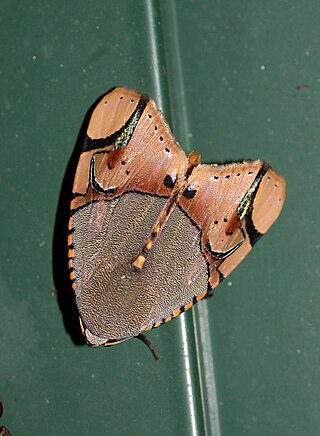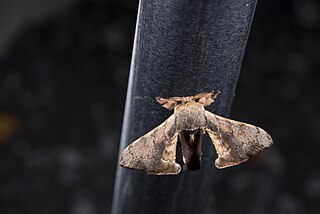
Hippotion celerio, the vine hawk-moth or silver-striped hawk-moth, is a moth of the family Sphingidae. It was described by Carl Linnaeus in his 1758 10th edition of Systema Naturae.

Mocis undata, the brown-striped semilooper, is a moth of the family Erebidae. The species was first described by Johan Christian Fabricius in 1775. It is found in the Afrotropical and Oriental regions, including India and Sri Lanka.

Dudusa sphingiformis is a moth of the family Notodontidae. It is found in Asia, including India, Burma, Korea and Japan.

Acosmeryx shervillii, the dull forest hawkmoth, is a moth of the family Sphingidae. The species was first described by Jean Baptiste Boisduval in 1875. It is found from the Indian subregion, Sri Lanka, to Sundaland, the Philippines and Sulawesi. Acosmeryx pseudonaga is sometimes treated as a valid species.

Amplypterus panopus, the mango hawkmoth, is a moth of the family Sphingidae. The species was first described by Pieter Cramer in 1779. It is found in Sri Lanka, southern and northern India, Nepal, Myanmar, southern China, Thailand, Vietnam, Laos, Indonesia and the Philippines.

Ramadasa pavo is a moth of the family Noctuidae first described by Francis Walker in 1856. It is found in south-east Asia. Including Sumatra, Borneo, Sabah, Sulawesi, Thailand, Sri Lanka, India and China.

Mustilia is a genus of moths of the Endromidae family. The genus was previously placed in the subfamily Prismostictinae of the Bombycidae family.
Mustilia falcipennis is a moth in the family Endromidae first described by Francis Walker in 1865. It is found in India and Bhutan.
Mustilia columbaris is a moth in the family Endromidae. It is found in India.

Trilocha varians, the Greenish silk-moth is a moth in the family Bombycidae described by Francis Walker in 1855. It is widespread in the Oriental region from India, Sri Lanka, China, extending to Taiwan, the Philippines, Pakistan, Sulawesi and Java.

Actinotia intermediata is a species of moth of the family Noctuidae. It is found in Asia, including India, Sri Lanka and Taiwan.

Europlema desistaria is a species of moth of the family Uraniidae first described by Francis Walker in 1861. It is found in India, Sri Lanka, Myanmar, Thailand, Taiwan, Borneo, Sulawesi, Flores and Queensland.

Phazaca theclata is a moth of the family Uraniidae. It was first described by Achille Guenée in 1858. It is known from Africa south of the Sahara, from Saudi Arabia, as well as from India, Japan, Myanmar, Nepal and Sri Lanka.
Epipristis minimaria is a moth of the family Geometridae described by Achille Guenée in 1858. It lives in India, Bhutan, Myanmar, Sri Lanka, Indonesia and Hainan and Yunnan provinces in China

Lacera alope, the toothed drab, is a moth of the family Erebidae. The species was first described by Pieter Cramer in 1780. It is found in Africa, where it is known from southern and eastern Africa, including several islands of the Indian Ocean, Saudi Arabia, and southern Asia from India, Sri Lanka to China.

Erebus hieroglyphica is a moth of the family Erebidae. It is found from the Oriental tropical countries such as India, Pakistan, Sri Lanka, Bangladesh, Japan, China, Taiwan, Cambodia, Laos, Myanmar, Thailand, Vietnam, Indonesia, Philippines, Malaysia, Singapore, and Korea. The habitat consist of lowland forests.

Erygia apicalis is a moth of the family Erebidae first described by Achille Guenée in 1852. It is found from the Indo-Australian tropics of India, Sri Lanka to Japan, Australia and the Solomon Islands. The habitat consists of lowland areas, including dry heath forests and softwood plantations.

Hypopyra vespertilio is a moth of the family Erebidae first described by Johan Christian Fabricius in 1787. It is found in China, Korea, Honshu in Japan, India, Sri Lanka, Nepal, Thailand, Myanmar, Cambodia, Vietnam, Taiwan, Malaysia, the Philippines, Java, Sumatra and Sulawesi.















